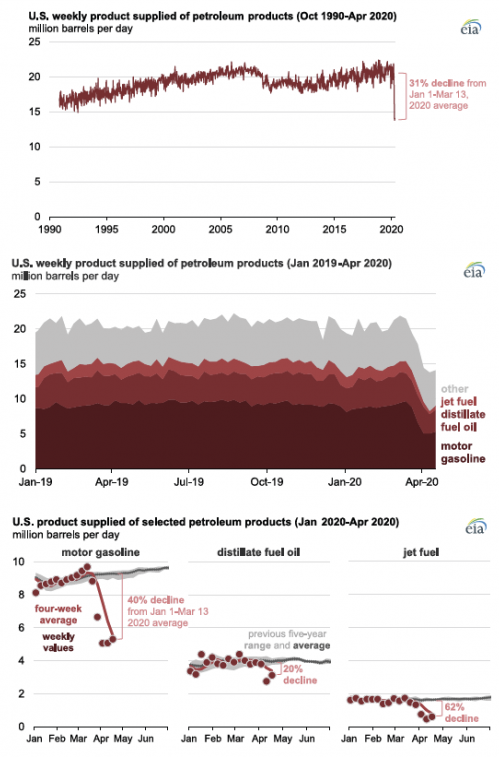All
COVID-19 Results in Lowest U.S. Petroleum Consumption in Decades

U.S. consumption of petroleum products has fallen to its lowest level in decades because of measures that limit travel and because of the general economic slowdown induced by mitigation efforts for the coronavirus disease 2019 (COVID-19). The U.S. Energy Information Administration (EIA) estimates the decline in petroleum product demand by examining the changes in total product supplied, EIA’s proxy for consumption. As outlined in EIA’s Weekly Petroleum Status Report, published April 22, total petroleum demand averaged 14.1 million barrels per day (b/d) in the week ending April 17, up slightly from 13.8 million b/d in the previous week—the lowest level in EIA’s weekly data series, which dates back to the early 1990s. The most recent value is 31 percent lower than the 2020 average from January through March 13, or before many of the travel restrictions began.
In the week ending April 3, total U.S. product supplied of petroleum products fell by 3.4 million b/d, the largest weekly decline in EIA’s data series. Changes in the weeks since then (weeks ending April 10 and April 17) have been more muted, suggesting that consumption is stabilizing.
Total petroleum demand measured as product supplied consists mostly of motor gasoline (45% of the 2019 total), distillate fuel oil (20%), jet fuel (9%), and chemical feedstocks and other fuels (26%). EIA uses estimates of product supplied from the Weekly Petroleum Status Report (WPSR) as a proxy for consumption because WPSR reports the amount of petroleum products that leaves the primary supply chain for ultimate delivery to consumers. The timing of changes in product supplied might not align with end-use consumption patterns because of variations in the timing of when respondents (such as refineries, importers, and bulk terminals) report movements of products within the primary supply chain.
Motor gasoline consumption has declined the most in absolute terms. Before many businesses were shut down and stay-at-home orders were issued, motor gasoline product supplied averaged 8.9 million b/d, based on 2020 data through March 13. Since then, motor gasoline product supplied has fallen 40 percent to 5.3 million b/d as of the week ending April 17. This decrease in motor gasoline product supplied accounts for 54 percent of the total change in product supplied. U.S. consumption of jet fuel experienced the largest drop in relative terms, declining 62 percent from a pre-shutdown average of 1.6 million b/d to just 612,000 b/d on April 17.
The decline in distillate fuel oil consumption so far has been less severe than the changes in motor gasoline and jet fuel. Through March 13, distillate product supplied averaged 3.9 million b/d in 2020. By the week ending April 17, distillate product supplied was 20 percent lower, at 3.1 million b/d. Distillate fuel oil is primarily consumed as diesel fuel, the predominant fuel of the trucking, locomotive, and agricultural sectors. Continued demand for distribution of necessities such as food and medical supplies and increased home deliveries for goods likely contributed to relatively stable demand for distillate fuel in the initial weeks following the shutdown.

Related Posts
 2025 Hedging Survey
2025 Hedging Survey
Posted on April 29, 2025
 Trump Policies and Energy Markets
Trump Policies and Energy Markets
Posted on April 28, 2025
 Hedging Strategies for Next Winter
Hedging Strategies for Next Winter
Posted on March 10, 2025
 A Volatile Start to the 2024-2025 Heating Season
A Volatile Start to the 2024-2025 Heating Season
Posted on December 9, 2024
Enter your email to receive important news and article updates.
